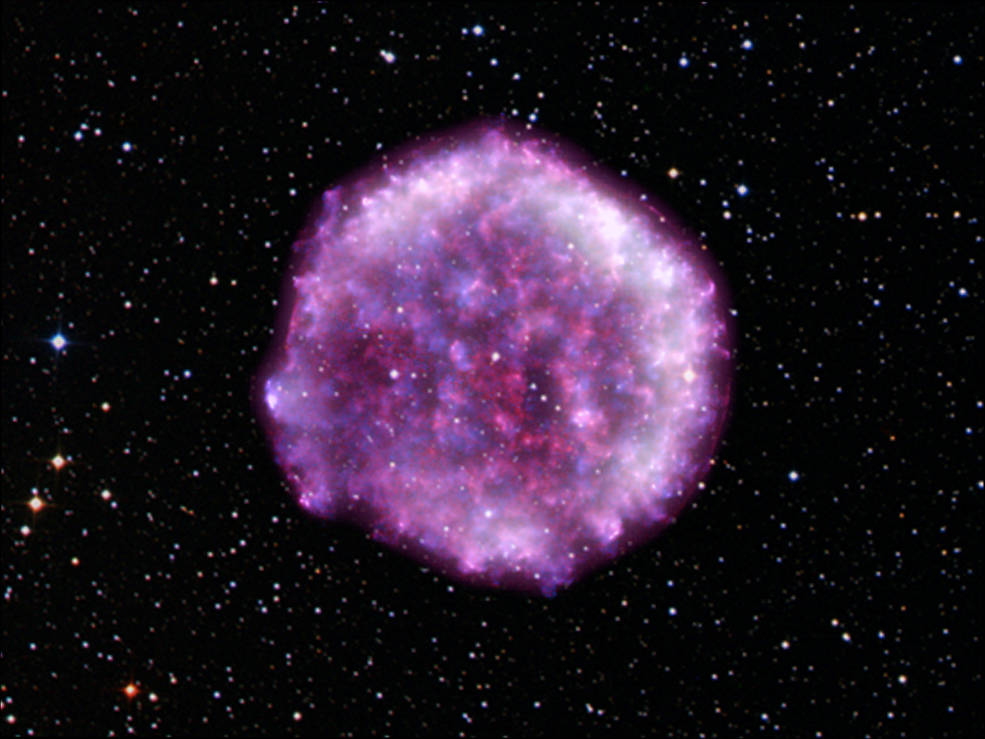An international team of scientists has uncovered new information about the remains of a star whose explosion was discovered 450 years ago. The results provided new clues about how the conditions in the shock waves created by titanic stellar explosions, called supernovae, accelerate particles to near the speed of light.
The supernova remnant is called Tycho, named for Danish astronomer Tycho Brahe, who noticed the bright glow of this new “star” in the constellation Cassiopeia in 1572. In the new study, astronomers used NASA’s Imaging X-ray Polarimetry Explorer (IXPE) to study polarized X-rays from the Tycho supernova remnant.

IXPE revealed, for the first time, the geometry of the magnetic fields close to the shock wave, which is still propagating from the initial explosion and forms a boundary around the ejected material. Understanding the magnetic field geometry allows scientists to further investigate how particles are accelerated there.
“As one of the so-called historical supernovae, Tycho was observed by humanity in the past, and had a lasting social and even artistic impact,” said Dr. Riccardo Ferrazzoli, a researcher at the Italian National Institute for Astrophysics in Rome, which partners with NASA on the IXPE mission. “It’s exciting to be here, 450 years after its first appearance in the sky, to see this object again with new eyes and to learn from it.” Ferrazzoli is the lead author of the newly published Tycho findings, which appear in the latest issue of The Astrophysical Journal.
Measuring X-ray polarization tells scientists the average direction and ordering of the magnetic field of light waves that make up X-rays from a high-energy source like Tycho. The polarized X-rays are produced by electrons moving in the magnetic field in a process called “synchrotron emission.” The polarization direction from the X-rays can be mapped back to the direction of the magnetic fields at the location where the X-rays were generated. This information helps scientists address some of the biggest questions in astrophysics, such as how Tycho and other objects accelerate particles closer to the speed of light than the most powerful particle accelerators on Earth.
“The process by which a supernova remnant becomes a giant particle accelerator involves a delicate dance between order and chaos,” said Patrick Slane, senior astrophysicist at the Center for Astrophysics | Harvard & Smithsonian in Cambridge, Massachusetts. “Strong and turbulent magnetic fields are required, but IXPE is showing us that there is a large-scale uniformity, or coherence, involved as well, extending right down to the sites where the acceleration is taking place.”
During its decades of operation, NASA’s Chandra X-ray Observatory has repeatedly observed the Tycho supernova remnant, helping researchers make landmark discoveries about this fascinating formation. With its ability to identify and track polarized X-ray light, IXPE builds on the groundwork laid by Chandra. Information from IXPE allows scientists to better understand the process by which cosmic rays, highly energetic particles that permeate our galaxy are accelerated by supernova remnants.
IXPE helped map the shape of Tycho’s magnetic field with unprecedented clarity and scale. Although previous observatories have looked at Tycho’s magnetic field in radio waves, IXPE measured the shape of the field on scales smaller than one parsec, or roughly 3.26 light-years – a vast size in terms of human experience, but the closest researchers have ever come to observing the source of the highly energetic “cosmic rays” emitted by one of these distant phenomena. This information is valuable as scientists explore how particles are accelerated in the wake of the initial explosion’s blast wave.
Researchers also documented similarities and surprising differences between IXPE’s findings at Tycho and at the Cassiopeia A supernova remnant, an earlier subject of study. The overall directions of the magnetic fields in both supernova remnants appears to be radial, stretched out along a direction extending outward. But Tycho yielded a much higher degree of X-ray polarization than Cassiopeia A, suggesting it may possess a more ordered, less turbulent magnetic field.
The Tycho supernova is classified as a Type Ia, which occurs when a white dwarf star in a binary system shreds its companion star, capturing some of its mass and triggering a violent explosion. The obliteration of the white dwarf sends debris hurtling into space at tremendous speeds. Such events are commonly believed to be the source of most of the galactic cosmic rays found in space, including those that continually bombard Earth’s atmosphere.
The Tycho supernova blast itself released as much energy as the Sun would put out over the course of 10 billion years. That brilliance rendered the Tycho supernova visible to the naked eye here on Earth in 1572, when it was spotted by Brahe and other stargazers, potentially including an 8-year-old William Shakespeare, who would go on to describe it in an early passage of “Hamlet” at the turn of the 17th century.
IXPE is a collaboration between NASA and the Italian Space Agency with partners and science collaborators in 12 countries. IXPE is led by NASA’s Marshall Space Flight Center in Huntsville, Alabama. Ball Aerospace, headquartered in Broomfield, Colorado, manages spacecraft operations together with the University of Colorado’s Laboratory for Atmospheric and Space Physics in Boulder.
Elizabeth Landau
NASA Headquarters
elizabeth.r.landau@nasa.gov
202-358-0845
Molly Porter
Marshall Space Flight Center
molly.a.porter@nasa.gov
256-424-5158

























